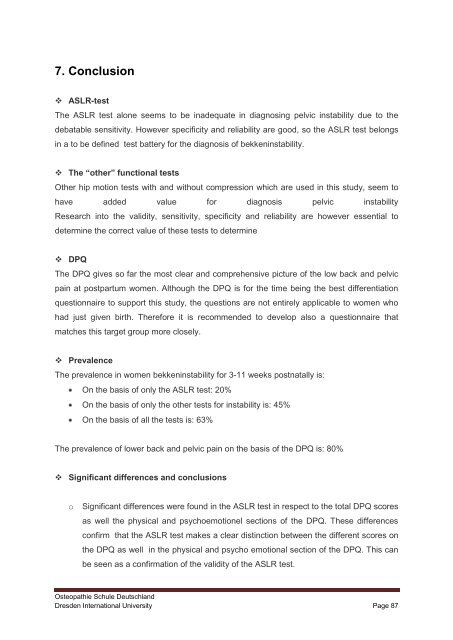Pelvic girdle pain and relevance of ASLR testing: A ... - Cindy Verheul
Pelvic girdle pain and relevance of ASLR testing: A ... - Cindy Verheul
Pelvic girdle pain and relevance of ASLR testing: A ... - Cindy Verheul
Create successful ePaper yourself
Turn your PDF publications into a flip-book with our unique Google optimized e-Paper software.
7. Conclusion<br />
<strong>ASLR</strong>-test<br />
The <strong>ASLR</strong> test alone seems to be inadequate in diagnosing pelvic instability due to the<br />
debatable sensitivity. However specificity <strong>and</strong> reliability are good, so the <strong>ASLR</strong> test belongs<br />
in a to be defined test battery for the diagnosis <strong>of</strong> bekkeninstability.<br />
The “other” functional tests<br />
Other hip motion tests with <strong>and</strong> without compression which are used in this study, seem to<br />
have added value for diagnosis pelvic instability<br />
Research into the validity, sensitivity, specificity <strong>and</strong> reliability are however essential to<br />
determine the correct value <strong>of</strong> these tests to determine<br />
DPQ<br />
The DPQ gives so far the most clear <strong>and</strong> comprehensive picture <strong>of</strong> the low back <strong>and</strong> pelvic<br />
<strong>pain</strong> at postpartum women. Although the DPQ is for the time being the best differentiation<br />
questionnaire to support this study, the questions are not entirely applicable to women who<br />
had just given birth. Therefore it is recommended to develop also a questionnaire that<br />
matches this target group more closely.<br />
Prevalence<br />
The prevalence in women bekkeninstability for 3-11 weeks postnatally is:<br />
On the basis <strong>of</strong> only the <strong>ASLR</strong> test: 20%<br />
On the basis <strong>of</strong> only the other tests for instability is: 45%<br />
On the basis <strong>of</strong> all the tests is: 63%<br />
The prevalence <strong>of</strong> lower back <strong>and</strong> pelvic <strong>pain</strong> on the basis <strong>of</strong> the DPQ is: 80%<br />
Significant differences <strong>and</strong> conclusions<br />
o Significant differences were found in the <strong>ASLR</strong> test in respect to the total DPQ scores<br />
as well the physical <strong>and</strong> psychoemotionel sections <strong>of</strong> the DPQ. These differences<br />
confirm that the <strong>ASLR</strong> test makes a clear distinction between the different scores on<br />
the DPQ as well in the physical <strong>and</strong> psycho emotional section <strong>of</strong> the DPQ. This can<br />
be seen as a confirmation <strong>of</strong> the validity <strong>of</strong> the <strong>ASLR</strong> test.<br />
Osteopathie Schule Deutschl<strong>and</strong><br />
Dresden International University Page 87


